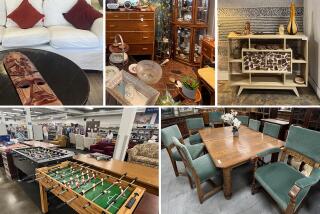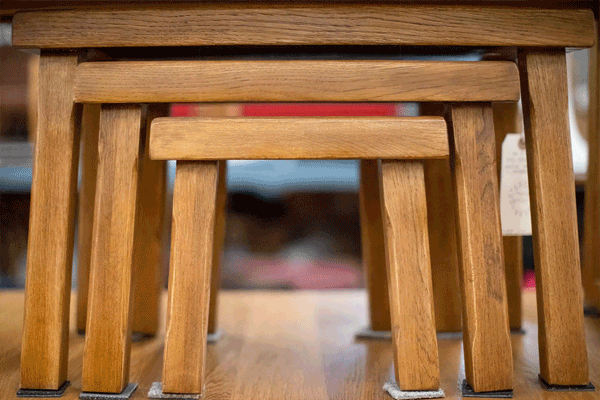No Room for Cheap Furniture : Decorating: An expert says it’s better to buy just a few pieces than lots of things that won’t last.
- Share via
Jackie and Charlie Roodenburg are newlyweds renting an apartment in Costa Mesa. Most of their furniture was accumulated by Jackie and her twin sister, Jody, during the past 10 years, with Charlie’s furnishings remaining with his ex-wife. The couple have just purchased a new car, and they figure it’ll take about five years before they can think about putting a down payment on a house.
Over the next half-decade, one of their biggest expenditures promises to be for new furniture.
“Actually, we’ve just been discussing that,” Jackie says. “We’re planning on getting a computer desk and a hutch or bookcase, or maybe a love seat and coffee table. We can’t afford to do it all yet, so we’re concentrating on the dining room and the den.”
That’s a good idea, according to RoxAnn Johnson, owner of Spatial Expressions, an Orange-based company specializing in interior design.
“What I would do, and what I suggest to clients who can’t buy everything at once, is to furnish the one or two rooms that they are going to use the most,” Johnson says. “In a lot of cases, that turns out to be the family room and the master bedroom.”
Even limiting purchases to a room or two could press family budgets to the limits. Johnson estimates that furnishing a three-bedroom, two-bath house with midline quality pieces could easily cost between $20,000 and $50,000.
“Of course,” she hastens to add, “that’s for a middle-class home. There are people who spend $20,000 to $30,000 on just one room.”
Johnson says only 1% of the population can afford “real” investment furniture, usually 17th- or 18th-Century antiques from Europe, or original, limited-edition handmade pieces produced by the world’s top designers. Such pieces can range from $15,000 to $50,000.
So what should the Roodenburgs and couples like them look for in more affordable furniture, without settling for bargain-basement pieces of questionable quality? Say, for instance, in a love seat or other upholstered seating?
Johnson’s advice is to start with the frame.
“If it’s a very good quality piece it should be made of hardwood,” she says. “The joints should be doweled, glued and stapled and possibly have corner blocks in them. With the less expensive sofas, the ones you see out there for $300 or $400, they may look good on the outside but the frame will start falling apart after a while because it’s made of pine and it’s just stapled together.”
After frame is examined, the support system should be scrutinized. Johnson says an eight-way, hand-tied spring system is desirable so that when you sit down on the sofa, each spring moves up and down independently.
“That means it has a lot of comfort in the seat itself,” Johnson explains. “Another sign of good quality is what we call ‘no sag’ springs, which are heavy gauge sinuous wire.” The better quality the sofa, the closer the springs are together, Johnson says. “That means there is better support and they don’t break down as fast.”
For the best quality, Johnson insists, the springs should be four to five inches apart and made of heavy gauge rather than seven to eight inches apart and consisting of thinner wire.
Next, the padding material should be checked to ensure that it contains high-quality foam, with cotton preferable to polyester. “It’s important you know what type of seat you want,” Johnson says, “whether you want soft, cushy, comfortable cushions or you want something more firm. The densities vary.”
For fabrics, Johnson recommends a durable, woven design or print tapestry made of chenille, leather or silk. She advises staying away from cotton chintz. “If you use fabrics that wear well, then you’ll get that kind of wear out of your piece of furniture,” Johnson says. “A sofa could last 20 or 30 years if it’s good quality.”
Now that the Roodenburgs and others know what to look for in a love seat or sofa, where should they look to make their purchase?
“I would suggest seeing an interior decorator, but I’m prejudiced,” Johnson admits. “But that’s what a decorator’s job is, to help people select and make the best purchases for getting value for their money.”
Alternatives, however, include shopping at better furniture and department stores. Watch out for sales that appear too good to be true. Such “deals” could be a result of cost-cutting production measures.
Johnson, who designs her own furniture in addition to helping commercial and residential clients select from manufacturers, offers these other tips:
Don’t buy on impulse. Have a plan before you go out shopping, take measurements and know what you’re looking for. “A lot of times, people go out looking in a furniture store and they see something that looks nice in the store. They buy the whole package, and while it’s matchy-matchy looking, it often doesn’t fit right and it isn’t as interesting as if you’d mixed pieces.
Keep scale in mind. In other words, don’t have a large, overstuffed sofa and two tiny, dainty chairs. Keep them balanced.
Don’t buy major pieces that are trendy. Trends change too frequently. Consumers are better off buying classic furniture and then adding less expensive accent pieces.
Know your budget. It’s better to get a few quality pieces than invest in a whole houseful of furniture that won’t last. Concentrate first on the rooms you use most frequently.
Taking into consideration the Roodenburgs’ needs and their limited budget, what would Johnson recommend to them?
“I’d tell them to put their money into upholstered pieces, because those are the ones that are going to take the wear and tear,” she says. “They should buy as good a quality as they can afford, in the fabrics, in the frame, the whole package.
“Things like chairs for dining room or kitchen tables are also important because they get used more. Make sure the legs are all the same length, that they’re glued and doweled, that they have stain-resistant, quality upholstery and have a good finish. They should invest their money in those pieces.”
If Jackie and Charlie Roodenburg buy their house five years from now, as planned, at least it should be well furnished.


